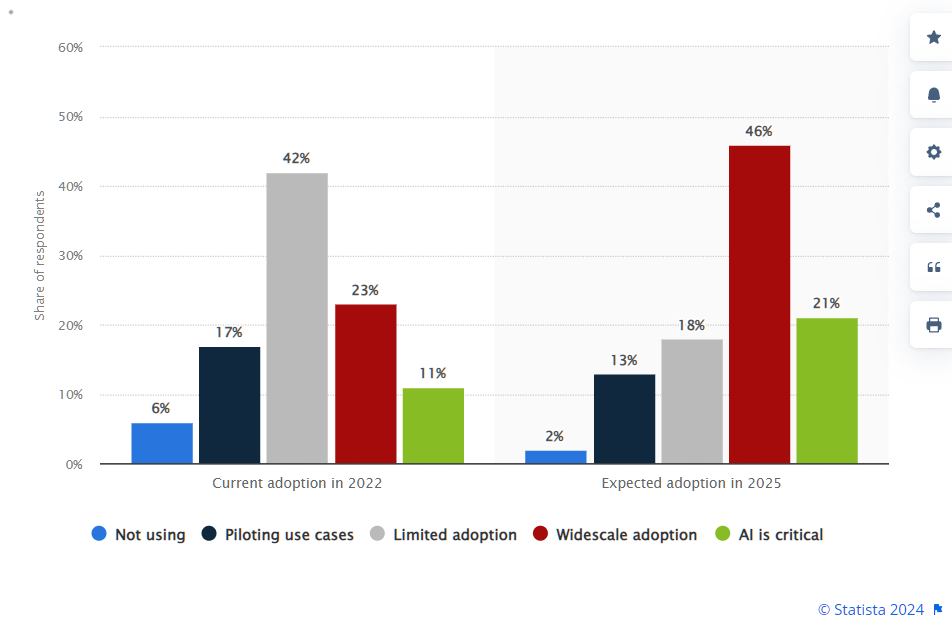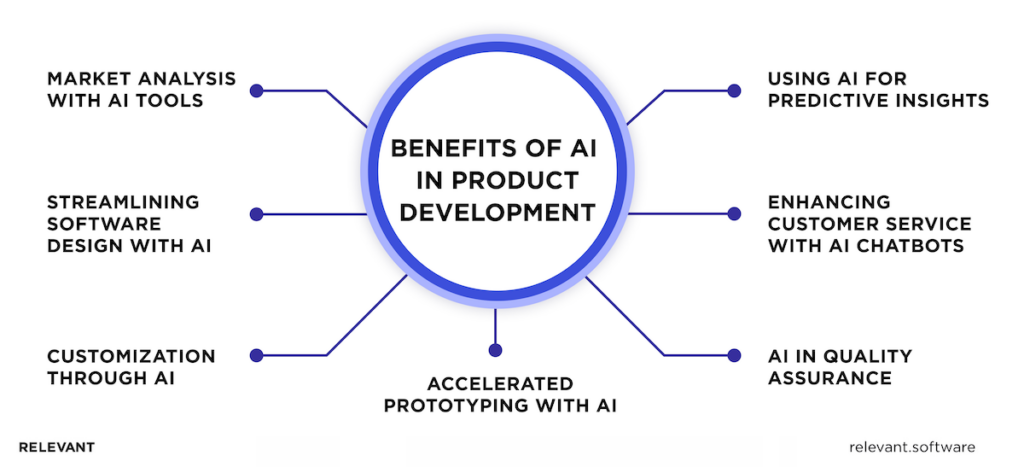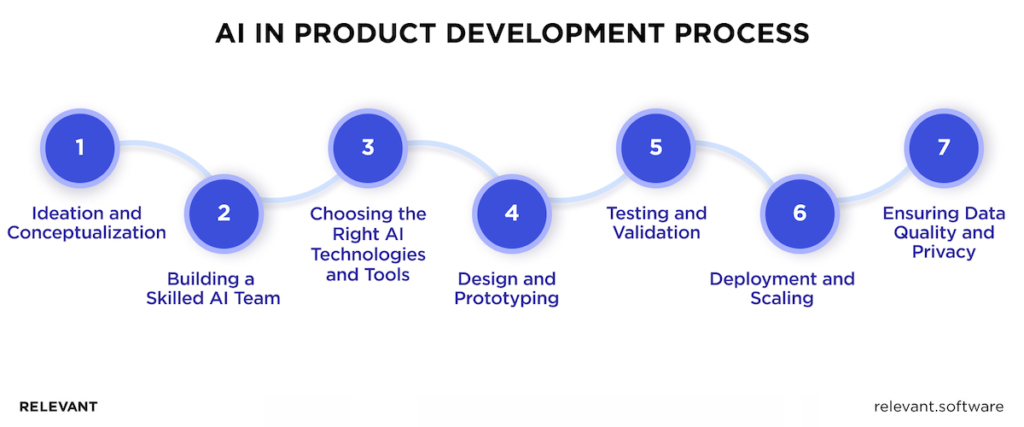AI in Product Development: How to Innovate Beyond Limits
Finding the right product to develop and spending on prototypes and tests can quickly drain a budget, often leaving business owners strapped for cash before they can even test their products. But the good news is that the latest breakthroughs of AI in product development completely overhaul this process.
Since our company is actively engaged in AI development services, it’s thrilling for us to perceive that, with AI under their belts, our clients are getting to market faster, gaining a competitive edge, and reducing manual tasks and guesswork. Certainly, it’s not always an easy path, but you know – only those who dared, won the rewards.
200+ companies from 25 countries outsourced software development to Relevant
We provide companies with senior tech talent and product development expertise to build world-class software. Let's talk about how we can help you.
Contact usPondering the integration of AI into product development? Then it will be useful for you to read this article.
Table of Contents
AI in Product Development: Short Overview
The rise in AI’s role across the board, from automotive to pharmaceuticals, and even in education and manufacturing, is a big hint that integrating AI in product development isn’t just nice to have, it’s a must.
PwC’s research showed that companies proficient in using AI and Machine Learning (ML) for product development, known as Digital Champions, generated over 30% of their revenue from digital products or services. Therefore, it is expected that AI in the product development market will jump to $407 billion by 2027.
The graph below highlights the global uptake of artificial intelligence in product development companies in 2022 and projections for 2025.

Source: Statista
Benefits of Integrating AI into Product Development
Incorporating innovation like AI in product development process brings forth a spectrum of advantages. We will list some of them:

#1 – Market Analysis with AI Tools
A McKinsey report highlights the potential for AI to deliver up to a 1600% ROI by sifting through extensive datasets to pinpoint market opportunities hidden within trends, surveys, and social media. This saves time and cuts development costs, enabling teams to channel their efforts into more creative endeavors. With tools such as Google Analytics and IBM Watson, you employ AI in product development to make decisions much in the same way Netflix does about its content.
#2 – Using AI for Predictive Insights
Fundera notes that 35% of small businesses fail due to insufficient demand. AI emerges as a critical tool in this scenario, offering precise analytics to help startups grasp market needs and consumer demands, thus guiding more informed product decisions. Predictive analytics tools like DataRobot and H2O.ai equip startups with the insights necessary to gauge market needs, similar to how Spotify utilizes AI to forecast music trends.
#3 – Customization through AI
A Salesforce report reveals that 84% of customers favor companies offering personalized experiences. AI in product development shines in parsing user data to deliver these customized interactions, including targeted ads and bespoke product recommendations, thereby boosting customer satisfaction and loyalty. Platforms like Kibo Commerce and Adobe Experience Platform leverage AI in product development in ways similar to Amazon’s recommendation engine, analyzing customer data to craft personalized experiences.
#4 – Streamlining Software Design with AI
Forrester’s research suggests AI-powered design tools can cut software development time by up to 30%. AI, particularly generative AI product development, can evaluate past projects and propose design improvements, making products more innovative and user-friendly. Solutions such as Microsoft’s Sketch2Code and Adobe Sensei provide AI-assisted design, streamlining the process in a manner akin to Autodesk’s method.
#5 – Enhancing Customer Service with AI Chatbots
A study by Jenkins found that 67% of consumers have interacted with a chatbot for customer support in the past year, showcasing how AI chatbots are transforming customer service by providing round-the-clock assistance and shortening wait times. Platforms like Google’s Dialogflow and IBM’s Watson Assistant drive these AI chatbots, enhancing customer interactions, a strategy successfully implemented by HSBC.
#6 – AI in Quality Assurance
Capgemini reveals that AI-powered testing tools identify software defects 40% faster than traditional methods. Advanced AI functionality applied to testing processes significantly accelerates the development process and even boosts the quality of products. For example, Selenium and Testim.io integrate AI for faster defect identification, enhancing product quality as seen in Microsoft’s testing processes.
#7 – Accelerated Prototyping with AI
Traditionally, creating a prototype could take up to 12 weeks, but AI has revolutionized this process, enabling rapid prototyping and the creation of physical components through generative design. Tools like SolidWorks and Autodesk Fusion 360 leverage AI in product development for quicker design iterations, much like how BMW speeds up its vehicle design process.
The AI Product Development Process
At its core, integrating AI in product development process means leveraging data and algorithms to enhance every stage of the process—from the concept development to the moment a product hits the market. For those in the trenches—business strategists, product managers, and decision-makers—grasping how to meld AI product development strategies is not just beneficial; it’s essential for staying ahead in a competitive landscape.

Ideation and Conceptualization
The process of AI integration starts with identifying problems and opportunities where AI can be applied. It typically includes complete market research, stakeholder discussions, and trend analysis to pinpoint areas where AI-driven solutions can offer value or innovation.
Expert Tip from Relevant: Sometimes, the most valuable use cases for AI aren’t immediately obvious but can be uncovered through deep analysis of how users interact with your current product. Look for patterns or pain points that AI in product development could address. Pair this insight with a SWOT (Strengths, Weaknesses, Opportunities, Threats) analysis specifically focused on AI product development opportunities to prioritize your initiatives strategically.
Building a Skilled AI Team
A competent team is the backbone of successful AI and product development. If you don’t have a skilled AI team in-house, you need to hire AI engineers, data scientists, product managers, and UI/UX designers who understand how to make AI functionalities accessible to users and how to solve real-life problems.
Expert Tip from Relevant: Prioritize adaptability and continuous learning in your hiring criteria. Since the AI field evolves rapidly, team members who are committed to staying on top of new methodologies of AI in product development will be invaluable.
Choosing the Right AI Technologies and Tools
Selecting an appropriate AI toolkit is a foundational step in the AI product development process. Tools and platforms should be chosen based on their ability to support the AI model’s development, training, and deployment phases efficiently. This might include cloud-based AI services for scalability, frameworks for machine learning model development, and tools that facilitate easy integration of AI functionalities into products.
Expert Tip from Relevant: Beyond assessing current technology needs, consider the long-term viability and support for the AI technologies you select. Engage with the community around these technologies; active participants often mean robust support and longevity for the tools.
Related: Right Language for AI: What’s Hot, What’s Not
Design and Prototyping
AI driven product development involves selecting suitable AI models and developing initial versions of the product. The prototyping stage is fundamental for seeing the AI solution in real life and for early feedback gathering. This moment allows for necessary design tweaks before heavy investment. It’s an iterative process that helps in refining the AI product’s usability and effectiveness.
Expert Tip from Relevant: Embrace a fail-fast philosophy here. Use rapid prototyping techniques and be prepared to pivot based on what you learn, keeping the user’s needs at the forefront of your design process.

Testing and Validation
These practices are imperative to ensure that AI powered product development meets quality and performance standards. Using techniques like A/B testing, user testing, and performance benchmarking can be handy to evaluate the AI model’s accuracy, reliability, and user experience. This phase identifies potential issues and areas for improvement, making sure the product meets the key metrics for product development in AI.
Expert Tip from Relevant: Integrate explainability and transparency into your AI testing processes. Understanding why an AI model makes certain decisions is crucial, especially if the outcomes will directly impact your users. This insight can also simplify troubleshooting and refine the model.
Deployment and Scaling
Deploying and scaling AI tools for product development requires careful planning to manage infrastructure needs, data security, and user support. Challenges in scaling AI solutions include ensuring consistent performance under varying loads and integrating with existing systems and technologies.
Expert Tip from Relevant: Adopt a modular architecture for your AI systems. This approach to AI for product development allows you to scale components independently and integrate new functionalities without overhauling the entire system. It’s also crucial for staying agile in the face of evolving user needs or the technology scene.
Ensuring Data Quality and Privacy
Maintaining data quality and ensuring privacy is paramount throughout AI ML product development. This involves implementing robust data management practices, securing data storage and transmission, and complying with data protection regulations such as GDPR.
Expert Tip from Relevant: Implement end-to-end encryption for data in transit and at rest, and practice the principle of least privilege access. Regularly review and update your data privacy policies to reflect new regulations and best practices of AI in product development.
AI in Product Development: Bottomline
Integrating artificial intelligence or AI in product development isn’t quite as straightforward as merely ideating a feature and having AI bring it to life instantaneously. While that might be a reality in the future, we’re not there yet.
Currently, the process of developing a product still heavily relies on your unique creative flair, your strategic guidance, the insights gleaned from data, and your carefully formulated hypotheses. As we draw this discussion to a close, it’s essential to highlight a few critical points to keep in mind:
- Prioritize overarching strategic planning while delegating the more mundane tasks to AI. This allows you to focus on the vision and direction of your product development AI to handle the labor-intensive aspects.
- Recognize the discrepancy that often exists between your expectations of how customers will interact with your product and the reality of their actual usage patterns. AI can be a key asset in narrowing this gap, offering insights that help align your product more closely with user needs.
- A product’s ability to genuinely solve a widespread problem is a hallmark of its success. So, gaining nuanced, context-specific AI insights is crucial for identifying such problems accurately and building solutions that effectively address them.
It’s worth mentioning that Relevant can steer you in the right direction with our AI product development services. Working alongside our clients, we leverage new technologies and trends to create innovative products and solutions. Whether you’re contemplating a new product idea or seeking support for an existing project, our team is equipped and eager to assist.
Our core services:
Do you want a price estimate for your project?
Do you know that we helped 200+ companies build web/mobile apps and scale dev teams?
Let's talk about your engineering needs.
Write to us











